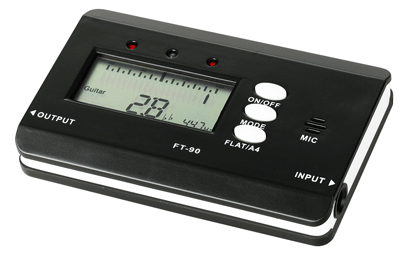You will need
- Guitar, tuner.
Instruction
1
Pick up a guitar. Place the included tuner near you. For example, at the knee. The point is that the sound produced by the instrument, was heard by the tuner.
2
Pull the first string of the guitar. Your tuner should respond to voiced sound change of the indicator.
Typically, the indicators show the nearest note name and degree of its deviation from the nominal frequency. If the indicator is deflected to the right, so the string sounds higher value and need to relax. If left, then the string should be slightly tightened. Deviation indicator is sometimes referred to by the signs # (sharp) and b (flat). Sharp means the string needs to relax, flat – the string needs to be tightened.
This is particularly the case when the string slightly upset. I.e., the indicator displays the note name, the height of which you want to configure the string. For example, in our case, the first string should sound like the note mi. This note is denoted by the letter E.
Typically, the indicators show the nearest note name and degree of its deviation from the nominal frequency. If the indicator is deflected to the right, so the string sounds higher value and need to relax. If left, then the string should be slightly tightened. Deviation indicator is sometimes referred to by the signs # (sharp) and b (flat). Sharp means the string needs to relax, flat – the string needs to be tightened.
This is particularly the case when the string slightly upset. I.e., the indicator displays the note name, the height of which you want to configure the string. For example, in our case, the first string should sound like the note mi. This note is denoted by the letter E.
3
Adjust the string until, until the indicator show the designation of the notes mi (E), and the meter needle does not stay clear in the middle. The sign E denoting the e in the row of symbols is between the D and F. Fully music letters is denoted as: A (La) B (si) C (to) D (re) E (mi) F(FA) G (Sol). Sometimes the sound of si denoted by the letter H.
4
Set up the same way the other strings of the guitar. In the classical setting six-string guitar, the second string must be configured on the si, and the third in salt fourth in d, fifth in La, sixth in mi.
Note
Please note that it is not always the guitar is set up in classical formation.
Useful advice
If you are setting up an electric guitar, your tuner, for example, built into a guitar processor or an independent device with an input for a guitar cable, you will need to connect the guitar to the input of the tuner, then the action algorithm is the same as described above.
There are software tuners for the computer and even for mobile phones.
There are software tuners for the computer and even for mobile phones.
